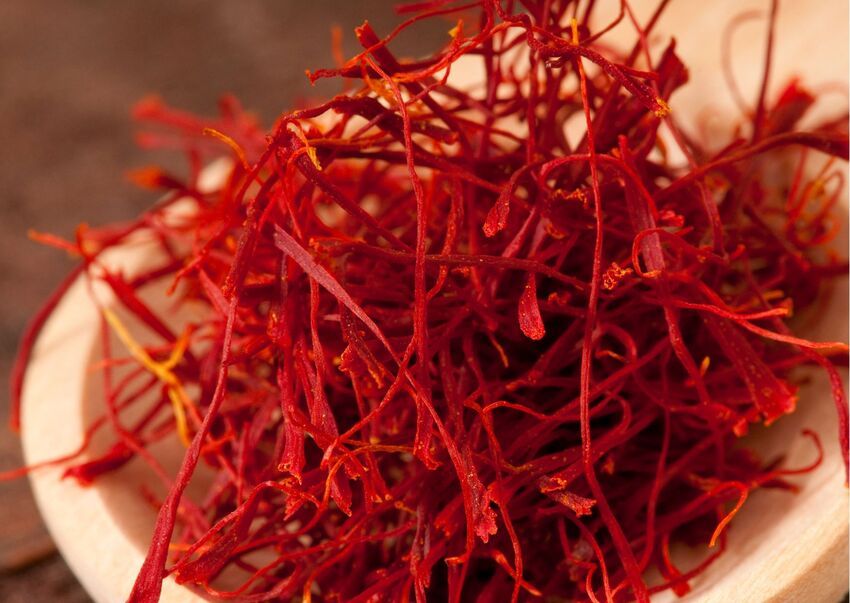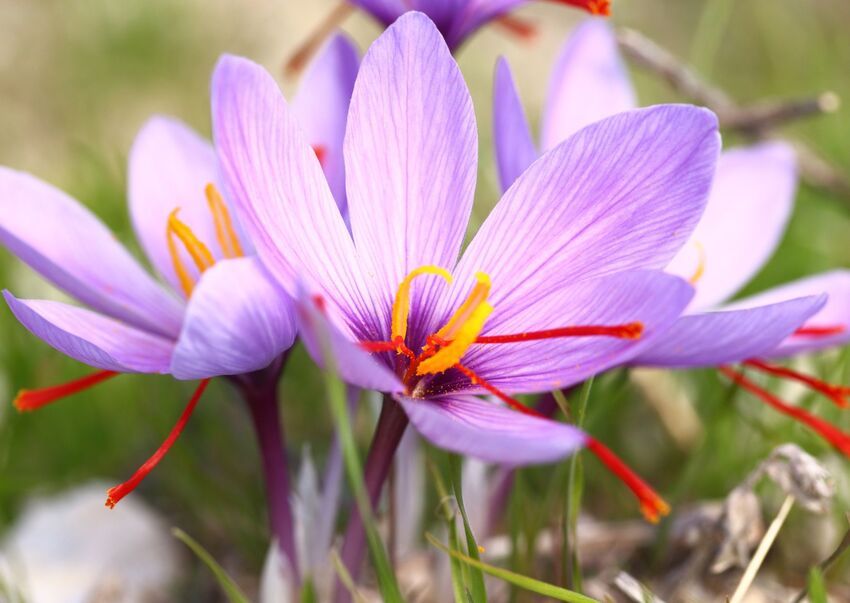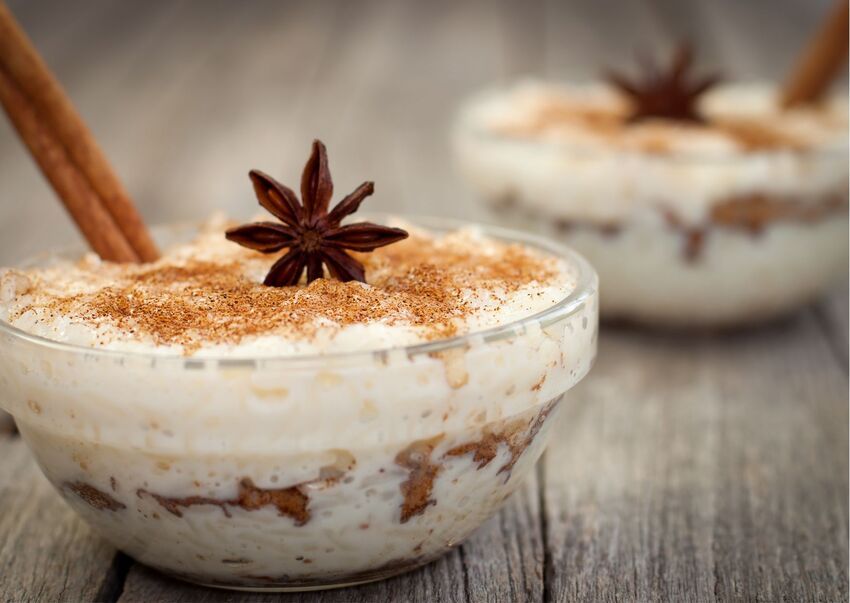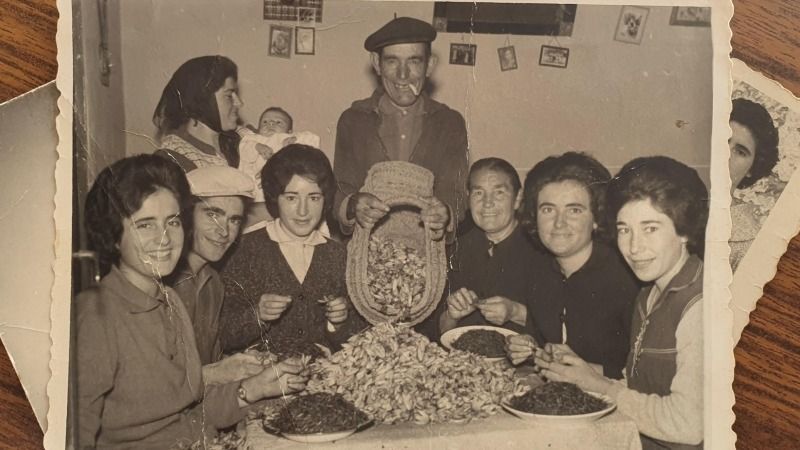Spanish cuisine is a dazzling array of flavors, colors, and aromas, each region contributing its distinct culinary gems. At the heart of these various culinary practices is one spice that binds all these different tastes into one cohesive narrative—saffron. Saffron in Spanish cuisine adds a unique and vibrant touch to many traditional dishes, infusing them with its distinctive flavor and brilliant golden hue. But what Spanish dish uses saffron, and why has it gained worldwide recognition?

What is Spanish Saffron?
Spanish saffron is highly prized for its quality and intensity of flavor. The La Mancha saffron has received a Protected Designation of Origin (PDO) status from the European Union, which guarantees the product’s authenticity and superior quality.
Also known as ‘Red Gold,’ Spanish saffron derives from the Crocus Sativus flower. Cultivated primarily in the La Mancha region, it is revered for its deep aroma, vibrant color, and distinct taste. This spice not only enhances the visual appeal and fragrance of dishes but also adds a subtle, slightly bitter depth of flavor that is essential in Spanish gastronomy.
Spanish Saffron: The Golden Spice
Spanish saffron is highly prized for its quality and intensity of flavor. The La Mancha saffron received a Protected Designation of Origin (PDO) status from the European Union, which guarantees the product’s quality and geographical origin.

Spanish Saffron, also known as ‘Red Gold’, is a prized spice which derives from the flower of Crocus Sativus. Cultivated in the La Mancha region, it’s revered for its unique aroma, vibrant color, and distinct taste. Not only does it lend an appealing hue and aroma to dishes, but its distinct, slightly bitter flavor adds complexity to Spanish gastronomy.
Harvesting Saffron: A Labor of Love
Saffron cultivation is no walk in the park. It’s a labor-intensive process where the delicate stigma of the saffron crocus is handpicked during the few weeks of its blooming season. It’s then carefully dried under tightly controlled conditions. This process imparts saffron its distinct characteristics, making it the world’s most expensive spice by weight.

What Spanish Dish Has Saffron?
One of the most famous Spanish dishes that prominently features saffron is Paella. This world-renowned dish originated in Valencia and is known for its aromatic, flavorful rice infused with the golden hues of saffron. The spice not only enhances the dish’s rich flavors but also provides the signature yellow color that defines authentic paella.
Paella Valenciana: A Symphony of Flavors
This quintessential Spanish dish, is a perfect embodiment of the saffron’s magic. Indeed, saffron is a key ingredient of the traditional Paella Valenciana, The saffron strands infuse the rice with a beautiful golden hue and a unique flavor, which harmonizes the different elements in the dish.
Sopa de Ajo: A Comforting Broth
You can prepare the traditional Spanish dish of garlic soup with with old bread, garlic, paprika, and topped with a poached egg. You can add Saffron to this hearty broth, which offers a unique depth and a slight sweetness that balances the robust flavors of garlic and paprika.
Zarzuela: A Seafood Delight
Zarzuela is a traditional seafood stew, often containing fish, prawns, mussels, and clams. This rich stew is given a flavorful twist with the addition of saffron. The spice beautifully complements the seafood, enhancing the overall taste of the dish.
Arroz con Leche: A Sweet Ending
Saffron isn’t limited to savory dishes in Spanish cuisine. The classic dessert, Arroz con Leche, which is a type of rice pudding, often features saffron. The spice imparts a lovely yellow color and a slight bitterness that balances the sweetness of this comforting dessert.

What is Spanish saffron used for besides cooking?
Saffron’s role in Spain extends beyond the kitchen. Its medicinal properties are well documented in traditional Spanish medicine.
The Spice of Economy
The cultivation and export of saffron play a significant role in Spain’s economy. La Mancha, known as the ‘Saffron Coast’, is home to many saffron farms that contribute to the country’s economy.
Saffron: A Tradition and A Dowry
In La Mancha, saffron is more than just a spice—it is a cherished cultural tradition. Historically, saffron cultivation played a significant role in marriage customs, where it was grown as part of a bride’s dowry. Given its economic value, the earnings from saffron contributed to wedding expenses and household necessities, reinforcing its importance beyond the kitchen.
This tradition reflects the deep connection between saffron, societal norms, and economic stability in La Mancha. Women played a vital role in preserving and passing down this heritage, symbolizing saffron as more than just a seasoning but as a representation of love, commitment, and continuity. The golden threads of saffron, much like marriage, weave the past with the future, securing its place in Spanish culture.

Frequently Asked Questions
1. Why is Spanish saffron so expensive?
Spanish saffron is expensive due to the labor-intensive harvesting process and the high demand for this high-quality spice.
2. In which dishes you can use saffron in Spanish cuisine?
You can use Saffron in many dishes in traditional Spanish cuisine, including Paella Valenciana, sopas de ajo (a both made with garlic), zarzuela de marisco (a traditional seafood stew), various tapas, and some desserts like arroz con leche.
3. Where does saffron grow in Spain?
Saffron is primarily grown in the La Mancha region of Spain.
4. How does saffron affect the flavor of a dish?
Saffron brings not only a vibrant color but also a unique flavor and aroma to dishes. It adds a distinct flavor that is slightly bitter yet sweet, enhancing the overall taste profile of a dish. It also imparts a beautiful golden color.
5. Can I substitute saffron with other spices?
While there are substitutes for saffron, none can truly replicate its unique aroma, color, and flavor.
6. How is saffron harvested?
Saffron is harvested by handpicking the delicate stigma of the saffron crocus during its blooming season. It’s then carefully dried under controlled conditions.



